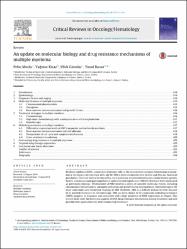| dc.contributor.author | Mutlu, Pelin | |
| dc.contributor.author | Kiraz, Yagmur | |
| dc.contributor.author | Gunduz, Ufuk | |
| dc.contributor.author | Baran, Yusuf | |
| dc.date.accessioned | 2020-02-04T07:05:06Z | |
| dc.date.available | 2020-02-04T07:05:06Z | |
| dc.date.issued | 2015 | en_US |
| dc.identifier.issn | 1040-8428 | |
| dc.identifier.other | 1879-0461 | |
| dc.identifier.other | 10.1016/j.critrevonc.2015.07.003 | |
| dc.identifier.uri | https://hdl.handle.net/20.500.12573/109 | |
| dc.description.abstract | Multiple myeloma (MM), a neoplasm of plasma cells, is the second most common hematological malignancy. Incidance rates increase after age 40. MM is most commonly seen in men and African-American population. There are several factors to this, such as obesity, environmental factors, family history, genetic factors and monoclonal gammopathies of undetermined significance (MGUS) that have been implicated as potentially etiologic. Development of MM involves a series of complex molecular events, including chromosomal abnormalities, oncogene activation and growth factor dysregulation. Chemotherapy is the most commonly used treatment strategy in MM. However, MM is a difficult disease to treat because of its marked resistance to chemotherapy. MM has been shown to be commonly multidrug resistance (MDR)-negative at diagnosis and associated with a high incidence of MDR expression at relapse. This review deals with the molecular aspects of MM, drug resistance mechanisms during treatment and also possible new applications for overcoming drug resistance. (C) 2015 Elsevier Ireland Ltd. All rights reserved. | en_US |
| dc.language.iso | eng | en_US |
| dc.publisher | ELSEVIER SCIENCE INC, 360 PARK AVE SOUTH, NEW YORK, NY 10010-1710 USA | en_US |
| dc.relation.ispartofseries | Volume: 96; | |
| dc.relation.ispartofseries | Issue: 3; | |
| dc.relation.ispartofseries | Pages: 413-424; | |
| dc.rights | info:eu-repo/semantics/openAccess | en_US |
| dc.subject | Multiple myeloma | en_US |
| dc.subject | Molecular aspects | en_US |
| dc.subject | Drug resistance | en_US |
| dc.subject | Targeted drug delivery | en_US |
| dc.title | An update on molecular biology and drug resistance mechanisms of multiple myeloma | en_US |
| dc.type | other | en_US |
| dc.contributor.department | AGÜ, Yaşam ve Doğa Bilimleri Fakültesi, Moleküler Biyoloji ve Genetik Bölümü | en_US |
| dc.contributor.institutionauthor | | |
| dc.identifier.doi | 10.1016/j.critrevonc.2015.07.003 | |
| dc.relation.publicationcategory | Diğer | en_US |


















